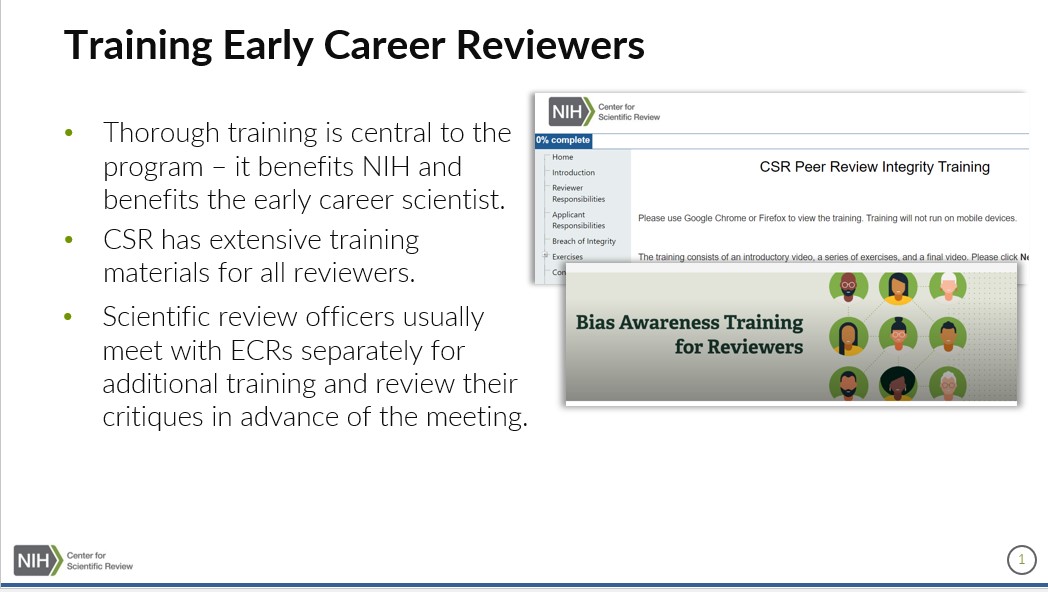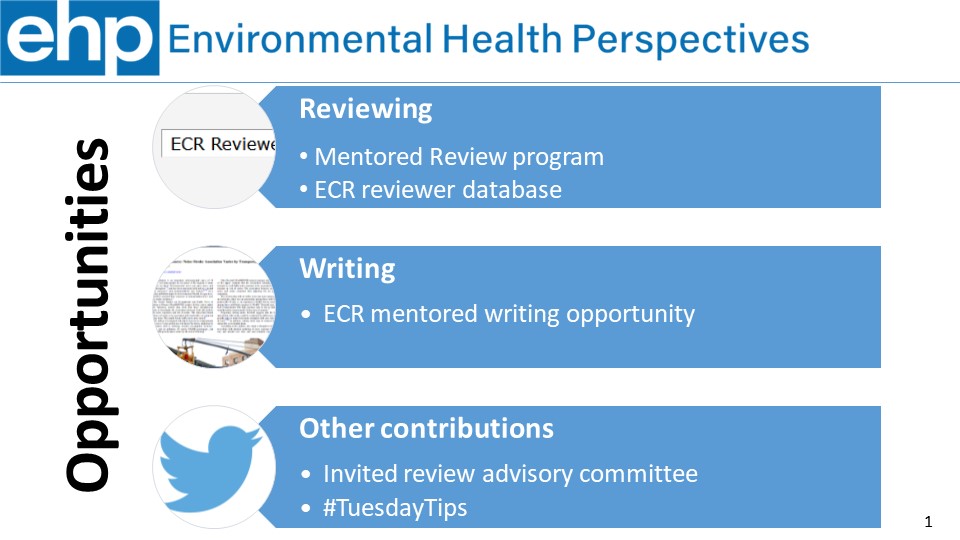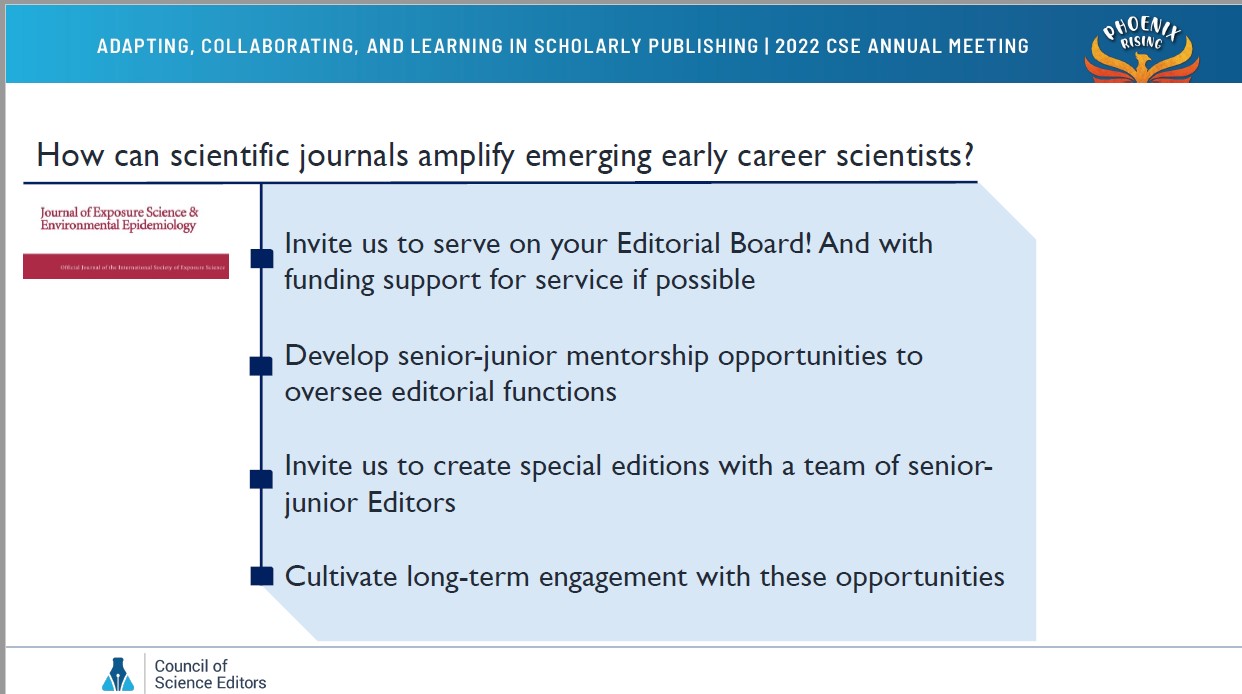MODERATOR:
Kristin Inman
Environmental Health Perspectives/NIEHS
Research Triangle Park, North Carolina
SPEAKERS:
Kristin Inman
Max Aung
University of Southern California, Keck School of Medicine
Los Angeles, California
@max_aung
Kristin Kramer
Center for Scientific Review
National Institutes of Health
Bethesda, Maryland
@csrpeerreview
REPORTER:
Erin Landis
Origin Editorial
Frederick, Maryland
The “Engaging Early Career Researchers” panel centered on the importance of attracting and retaining junior faculty both in research and in the process of scholarly publishing. The panel consisted of speakers all deeply involved with programs and initiatives for early-career researchers (ECRs).
Dr Kristin Kramer opened the session by explaining the scope of the National Institutes of Health (NIH) Center for Scientific Review (CSR), which is to provide first-level review of NIH grant applications. A pool of over 20,000 reviewers evaluates more than 66,000 applications annually. Dr Kramer explained that the process of reviewing grant applications varies from that of manuscripts for journals in 2 key ways: 1) the primary audience for the reviews is the NIH, as the goal of the review is to identify the highest impact science for funding consideration at the next stage of review and 2) the process is not iterative—resubmissions do not routinely go back to the same reviewers.
The NIH CSR has an early-career reviewer program; the goal of this program is to enrich the peer-reviewer pool and to provide first-hand review experience to early-career scientists as they prepare their own grant applications. Dr Kramer also explained that training is central to the program; there are extensive training modules and Scientific Reviewer Officers who meet with ECRs to provide additional training (Figure 1).

Outcomes of the program show that recruitment of ECRs increases panel diversity and that success rates for ECR grant applications are promising. Surveys of ECRs in this program show that, overwhelmingly, they feel prepared to develop their own grant applications. Dr Kramer concluded her talk by noting some of the challenges of the program, including recruiting and managing expectations.
Dr Kristin Inman followed Dr Kramer with a talk on the ECR initiative of her journal, Environmental Health Perspectives, which is a self-published Diamond Open Access journal. It is also a leading journal in the field of environmental health sciences. The goals of the ECR initiative are to engage the environmental health sciences ECR community and foster the development of quality reviewers, editors, and authors. To achieve these goals, the journal first formed an early-career advisory panel, which provides input for the journal.
Specific components of the initiative include a mentored review program, an ECR reviewer database, ECR-mentored writing opportunities, inclusion on an invited review advisory committee, and a Twitter campaign called #TuesdayTips that shares resources relevant to ECRs. ECRs can also contribute content to the campaign (Figure 2). Dr Inman shared other ECR-related initiatives that are in development including a robust reviewer resource page that contains a lot of valuable information for ECRs, an editor-in-training program, and digital learning modules. Similar to Dr Kramer, Dr Inman highlighted some challenges of the journal’s ECR program including determining how to measure success, communicating with a diverse group, and recruiting and tracking ECRs.

Dr Max Aung rounded out the session by explaining his experience with various ECR programs he has been involved with as an ECR. For the Robert Woods Johnson Research Scholar Program, Dr Aung was provided with 4 years of support, including funding and professional development, health policy training, workshops, science communication training, and ongoing mentoring. For the Agents of Change program he participated in, he engaged in a 9-month fellowship and was afforded the opportunity to publish a first-person narrative essay. Additional elements of the program are the ability to participate in and produce an episode of a podcast and develop a scientific translation product focused on educating community groups and policymakers. Long-term hallmarks of these programs included the development of long-lasting networks, publications, podcasts, webinars, and essays.
Dr Aung concluded his talk by sharing his thoughts on how journals can help ECRs. His suggestions include developing senior/junior mentorship opportunities to oversee editorial functions and inviting ECRs to create special editions with a team of senior editors (Figure 3). He believes these types of opportunities will result in long-term engagement with journals by ECRs.

The session concluded with members of the audience sharing their experiences with ECRs at their journals.
